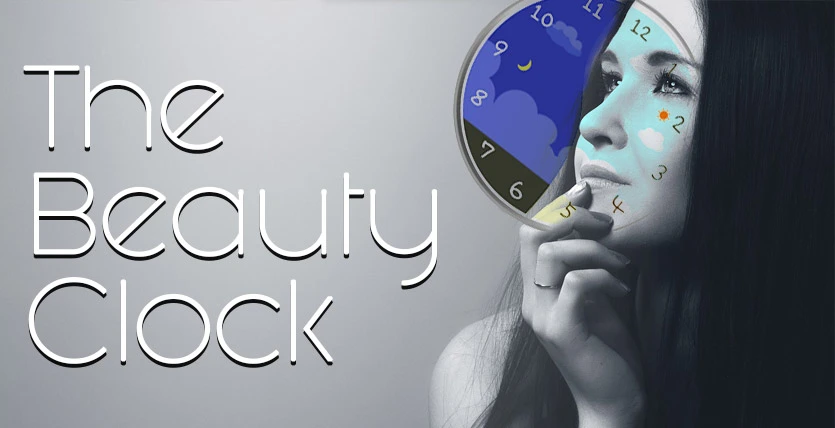Circadian Rhythm: Natural Beauty Clock for Your Skincare Routine

Circadian Rhythm helps you align your skincare routine just by understanding the natural beauty clock. Have you seen how your skin appears to look and feel changed throughout the day? It’s because the circadian clock adjusts to the light–dark cycle which incorporates the mood of the day or season, and automatically creates physiological and metabolic rhythmicity.
There is a circadian mood in the cells of the skin. It indicates you can do things to support a better beauty clock, which means the possibilities of a radiant complexion are within your reach. Before we look forward to how the skin’s clock follows the circadian rhythm, let’s first explore the concept of the biological clock.
What is Circadian rhythm?
Circadian rhythm is the internal clock of your brain. It is associated with the sleep/wake cycle. Our body is constantly adjusting to the physical, mental, and behavioral changes over a 24-hour day. Without this endogenous circadian clock, optimization of energy expenditure would not have been possible.
This biological system assists us to adjust to changes in our environment. It helps control our everyday timetable for rest and wakefulness. Sleep is a crucial activity. Lack of it can significantly affect our eating habits, hormone release, digestion, body healing, body temperature, memory consolidation, etc.
How do circadian rhythms function?
It is controlled by an expert clock in the cerebrum comprised of around 20,000 neurons, called the Suprachiasmatic Core. This master clock gets data through the eyes and it answers light and dark signals.
Light is first captured through the eyes. Our brain cells respond to light and dark and convey messages to various cells about when it is the ideal time to sleep or wake. Those cells then send signals to different organs that make you exhausted or active.
Melatonin makes you sluggish, and your body releases more of it in the evening. Cortisol makes you active, and your body produces a greater amount of it in the daytime. The body temperature decreases when you rest and rises during awake hours. Moreover, your metabolism works at various rates throughout the day. The other factors that influence our circadian rhythm are age, stress, physical activity, lifestyle, etc.
How Skin Cycles Follow Our Circadian Rhythm?
Like other parts of the body, our skin is consistently working and continuously changing. The circadian or biological clock inside the skin is always ticking. It affects not only cell proliferation or skin tissue growth but also cell migration.
The biggest organ of the human body comprises several layers. The epidermal cells are in a consistent condition of change. Human skin replaces itself every 35 days or so, but the skin cycle of cell turnover of the epidermis slows down as we age. This changeover of the epidermal layer can be adversely impacted by circadian rhythm disorder.
What elements can negatively affect skin health?
Skin health can be negatively affected by stress, health conditions, overnight or erratic work shift hours, medical issues, jet lag, excessive screen watch time before sleep that is the blue light of computers, cellphones, tablets, televisions, etc, not having a comfortable napping space, poor sleep habits, etc.
What happens if your circadian rhythm is messed up?
If the circadian rhythm is out of whack, multiple dermatologic disorders may transpire. Dry skin, dark circles under the eyes, development of wrinkles and fine lines, etc may happen because the skin doesn’t get an opportunity to repair itself. A 7-9 hours of sleep per night is recommended for the well-being of our body and skin. ·
Why The Time of Day Matters for Skin Care Products?
Many skin factors are affected by Internal clock clashes. Sebum production, hydration, and skin temperature are all countered in a circadian way. The skin care product should be used at specific times. Let’s understand why the time of day matters for skin care products.
Your skin during the day
During the day, the skin gets heat exposure from the sun, free radicals, pollution, etc, and despite the aggressors, it is safeguarding itself.
The surface temperature of the skin is lowest in the morning. At the peaks of early afternoon, the sebum production increases thus, constructing a naturalistic shield to guard itself from the environment. That is the reason, the skin is oily by the end of the day.
During this time of the day, the skin is good at retaining moisture.
Its hydration levels are maximum and the natural antioxidant production is increased. It attempts to safeguard itself from DNA harm brought about by free radicals. Due to increased antioxidant production and adequate moistness, it is less receptive to skincare items.
Your skin during the night
Daytime is about protection. Nighttime is the time when the skin works on restoring any harm that has occurred throughout the day. Even though the skin constantly tries to mend itself, repairing is at its peak during the night. The main goal of our night sleep is repair and rejuvenation.
What Skin Care Products should be applied during the day and night?
Day– The application of a good sunscreen lotion with SPF 30 is a vital step in the morning. As per studies, UV rays can disturb the skin’s circadian rhythm for as long as 24 hours. Safeguard the skin with a good sun tan removal cream. Use more face serums. Vitamin C serum is a classic example of supplementing the natural shields. Antioxidants will give the skin a lift. Follow a proper skincare routine.
Night – The skin isn’t facing an onslaught of environmental aggressors. Now is the time when the skin is more receptive to products. Cells are developing at a higher rate during the night. DNA Repair & Regeneration help strengthen the skin’s immune system. Apply a well-formulated moisturizer to prevent water loss. Include Retinol, Antioxidants, Exfoliating acids like AHAs and BHAs, and Peptides as ingredients in your beauty products or you can prepare homemade serums, night creams, etc
Aligning Your Skincare Routine with Circadian Rhythm
The skin is a mirror of what’s happening within the body. The Circadian Rhythm directly affects and manages key processes like metabolic cycles, eating and digestion, rest and wake cycles, body temperature regulation, etc. Internal clock clash occurs due to lifestyle needs.
You need to work with Mother Earth and not against her. For instance, the key to getting rid of a blemish quickly is by working in sync with its natural life cycle and utilizing the right sort of spot treatment at the right time of the day you can optimize skin health.
Shut your cell phone off a couple of hours before bed. Remove electronic gadgets from your room. After taking a relaxing bath, go to sleep on a comfortable mattress with proper lighting. This beauty sleep will reflect on your face and you will wake up to beautiful skin!
Promote a healthy sleep-wake cycle. To boost your wakefulness, get your everyday dose of natural sunlight. By exposing yourself to the early morning natural light emitted by the sun you will feel less dizzy than usual. 20 minutes of vigorous activity or walking in the morning is a good idea.
A circadian rhythm disorder increases with age and can negatively affect skin health. Following the body clock not only influences cell proliferation or skin tissue growth but also helps in reducing stress.
Stopping or limiting exposure to blue light emission from electronic screen devices will guarantee that our skin’s melatonin creation isn’t being interrupted.
Frequently asked questions
Do visually impaired people experience circadian rhythms?
In the majority of blind individuals, the internal rhythm is desynchronization. They cannot scan or acquire light information, and they suffer from daytime hypersomnolence and nighttime insomnia. Visually impaired people can detect light around them but cannot synchronize with it and suffer from non-24-Sleep-Wake Rhythm Disorder. Despite exposure to sleep/wake schedules, they face circadian rhythm abnormalities.
What time is best for circadian rhythm?
If you wake up at around 7 AM, then the peak alertness or the best time will be around 2-3 hours after waking up, and active hours will be 9-10 after awakening.
What is the scientifically best time to sleep and wake up?
Count in reverse 7 hours from your wake-up time. (estimating 7 hours sleep minimum per night for adults) That is the time you should wind up down and go to sleep. For example, if you wake up at 5:00:A: M, then your bedtime will be 10:00 P: M.
How do I find my natural sleep cycle?
To find your natural sleep cycle observe your sleepiness. Start by noting a few things like- How tired you are over the day. What is your peak alertness time? What time is your body fatigued? If you nod off during a ride, or a meeting this is an indication that you may be sleep-deprived.
How do we understand the circadian clock for beauty?
Skin well-being is dependent upon a 24-hour cycle. Understanding it helps to combat premature aging and the absence of radiance. During the day, the thirsty skin will demand moisturizing and at night it will repair and regenerate itself. So, quality sleep is critical for skin health.
Conclusion
Every individual’s biological clock is affected by light and dark.
Sleep–Wake Disorder occurs due to lifestyle needs leading to numerous health and skin issues. Get an entire 7-9 hours of sleep before waking up. Improve your overall sleep quality and stay consistent.
Keep posting your inputs, experience, and opinions in the comments section.























